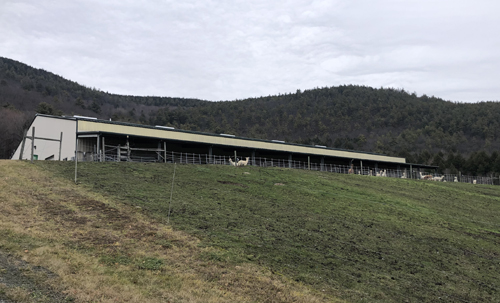Shifting Into Cold Weather Mode
As we commence our 24th year of operation here, there is an undeniable seasonal rhythm to the management of the farm that we have grown accustomed to. Though some things are obviously different in the autumn of 2020 — our lack of a fall show season, training the 2019 yearlings in short-sleeves on November 29th, which was nice if rather weird, loading truckloads of heavy wooden fence posts by hand while fully masked, which sucked — most of the day to day management on the farm follows a script that has now been repeated for the better part of two decades (we’ve been at our current layout and herd size for about 18 years) in one form or another.
As October came to an end, all members of the herd that had been rotationally grazing on some of our outer paddocks were brought back inside to a barn somewhere on the farm. Most notably, virtually all of the adult males — whether the front-line Herdsires who together saw about 95% of the breeding action during the spring and summer, the second-tier boys who still saw occasional duty, or those who are on the bubble but have stuck around nonetheless — returned to the smaller Stud Barn for the cold months of the year. Meanwhile, the 30+ open, mature females who had been housed there for breeding during the grazing season, rejoined the rest of our adult female herd up at the CCNF Arena. The lone group of fully mature males not living down at the Stud Barn over the winter in fact is our group of old guards (Messiah and Archangel are the headliners), who get their own special space and free-choice feeder at the Main Barn (that’s it in its first iteration in ’97 in the banner photo atop the blog). The humans on the farm always feel better the first time we wake up in the middle of the night to the sound of heavy winds and cold rain or sleet buffeting our house, knowing that the entire herd is again tucked away inside a barn with a layer of warm bedding, versus taking shelter under a now leafless maple or oak tree.

Perhaps the biggest transformation that takes place here each fall though, is the layout around the Arena, where the aforementioned female herd and their respective crias live each year until weaning. With the paddocks around that barn mostly grazed down to little green nubs by the end of October or early November, we fall back to the large dry-lot around the Arena and close off access to the surrounding pasture over the course of the winter. This serves multiple purposes: first and foremost the pasture just needs a break so that the grasses and other plants can recover; secondly with the animals off of the pasture and the temporary fencing down, our staff is able to get onto those pastures with equipment to top-dress them with last year’s now richly composted manure and bedding (what the amazing late Jack Lazor of Butterworks Farm fame here in Vermont has famously referred to as “feeding the little soil gods”); and lastly, there is also the simple alpaca husbandry consideration that we don’t want alpacas running and slipping on hillsides with 20+ degree grades (remember, we’re on the side of a mountain) when they become covered with snow and ice. Any added exercise benefit we are giving up there is quickly drowned out by the downside risk of soft tissue injuries and/or broken bones. We have of course experienced our fair share of both over the years – no bueno.
Though their adult mothers may not be as pleased by this turn of events, the next major shift here will occur when the entire feed group of 2019 yearling females that we’ve been show training, moves back up to the Arena from the Main Barn in the next week or so. That will in turn open up space at the MB, in preparation for the first round of weaners to leave their dams and come down the hill at the end of December. Then we will start to look forward to training 2020 juveniles for the Spring show season, come January/February/March. And round and round we go. Hope everyone reading this in the US had a great Thanksgiving last week. For all of the challenges that 2020 has presented us with, we in this family have so much to be thankful for. Please stay healthy, safe, and sane (you choose the order!) in the weeks ahead and we’ll be back again soon with more…
Follow me on Twitter at @CCNFAlpacas on Instagram at ccnfalpacas. You can find also find and follow CCNF on Facebook here.

Love your story. As I had to give up my llama/Alpacas due to age I love to hear how others r enjoying their fabulous herds.
Thanks Ann and thank you for reading!